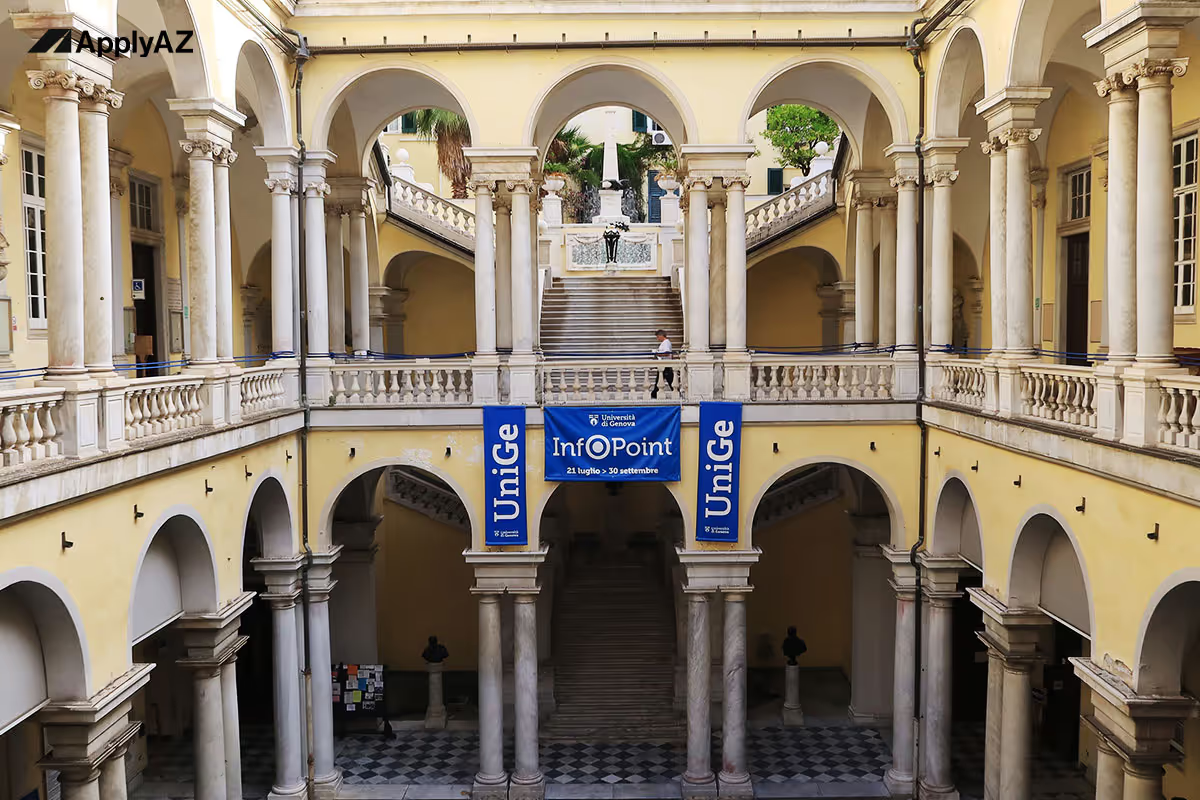Heading
Heading








University of Genoa
English‑taught programmes in Italy: why choose the University of Genoa
Founded in 1481 and consistently ranked among Europe’s leading maritime and engineering hubs, the University of Genoa offers more than 40 degree tracks taught partly or fully in English. This makes it one of the most versatile options for students seeking English‑taught programs in Italy while paying the regulated fees of public Italian universities. Incomes under specific thresholds can unlock the DSU grant, bringing total costs close to the levels often associated with tuition‑free universities Italy commentators mention. Key departments include naval architecture, robotics, computer science, biotechnology, and economics—each anchored by research centres that attract EU Horizon funding and private‑sector contracts.
Living and learning in a historic port city
Genoa stretches between mountains and sea, giving students a mild climate—winter averages 10 °C and summers hover around 28 °C. Shared flats in neighbourhoods like San Fruttuoso or Albaro cost roughly €300–€350 per month, and a €25 student travel pass covers buses, funiculars, and seaside trains. Cafeteria meals drop to €4 or even zero when the DSU grant applies. Cultural life blends Renaissance palaces, street‑art lanes, and open‑air concerts on the harbour. University sports clubs organise sailing, climbing, and coastal hikes, while language‑exchange cafés help you practise Italian after lectures.
Careers, internships, and industry links
Genoa is Europe’s busiest Mediterranean port and the core of Italy’s “Blue Economy.” Maritime giants, shipyards, and logistics groups recruit engineering and business students for roles in vessel design, supply‑chain analytics, and environmental compliance. The city also hosts the Italian Institute of Technology, famous for humanoid robots and smart materials—ideal for internships in AI, neuroscience, or nanotech. Biomedical start‑ups cluster around the university hospital, offering traineeships in gene therapy and medical imaging. Tourism and yachting sectors create seasonal part‑time jobs, useful for earning while studying. Career Services run bilingual CV workshops and link graduates to Erasmus+ traineeships across the EU.
Funding and academic support
Tuition scales from about €600 to €2 500 per year, depending on family income. Scholarships for international students in Italy include merit awards for high GPAs, fee waivers for refugee status, and lab assistantships that pay hourly. The DSU grant can waive tuition entirely, provide free meals, and contribute up to €7 000 toward rent and books—renewable when you pass 30 ECTS each year. The International Student Office helps with visa paperwork, health insurance, and accommodation lists, while the Language Centre offers free Italian courses from A1 to C1.
An inviting mix of heritage and innovation
Studying in Genoa means analysing wave mechanics in class and watching cargo ships glide past medieval city walls after hours. It means prototyping underwater drones in cutting‑edge labs, then testing them in the Ligurian Sea. Most of all, it means joining a diverse student body that values both tradition and forward‑thinking research. Choose Genoa if you want the networking ease of a medium‑sized city, the research muscle of a centuries‑old university, and cost structures that remain manageable thanks to Italy’s public‑education model and the DSU grant.
Ready for this programme?
If you qualify and we still have a spot this month, we’ll reserve your place with ApplyAZ. Our team will tailor a set of best-fit majors—including this course—and handle every form and deadline for you. One upload, many applications, guaranteed offers, DSU grant support, and visa coaching: that’s the ApplyAZ promise. Start now and secure your spot before this month’s intake fills up.
Digital Humanities – Interactive Systems and Digital Media (LM‑92)
1. A launch‑pad degree within English‑taught programs in Italy
Digital culture shapes how we read, curate, and share knowledge. This master’s in Digital Humanities – Interactive Systems and Digital Media sits among the most forward‑looking English‑taught programs in Italy. You will study in Italy in English, pay the regulated fees charged by public Italian universities, and stay eligible for grants that can reduce costs to figures comparable with many tuition‑free universities Italy discussions. Offered by the University of Genoa (Università degli Studi di Genova), the course unites computer science, interface design, and humanities theory to train professionals who build apps, exhibitions, and archives for a data‑driven world.
2. Programme structure: four intensive semesters, 120 ECTS
2.1 Semester 1 – foundations in code and culture
- Introduction to Digital Humanities (8 ECTS) – Explore textual criticism, encoding standards, and digital curation. Weekly labs clean OCR errors in Renaissance manuscripts.
- Interactive Media Programming I (6 ECTS) – Hands‑on JavaScript and Python for front‑end prototypes; assignments rebuild a basic annotated map.
- Information Design Basics (6 ECTS) – Typography, colour, and data‑visual grammar. Students draft dashboard sketches by week four.
- Research Methods for Humanities Data (4 ECTS) – SQL, regular expressions, and APIs for cultural datasets.
- Seminar: Writing and Presenting Research (2 ECTS) – Craft abstracts, lightning talks, and peer reviews.
2.2 Semester 2 – tools for analysis and experience
- Interactive Media Programming II (8 ECTS) – Frameworks such as React and D3. Mid‑term builds a scrolling story on migration records.
- Digital Textual Analysis (6 ECTS) – Stylometry, topic modelling, and sentiment analysis using R and Python notebooks.
- 3‑D Modelling and Immersive Media (6 ECTS) – Photogrammetry, Unity basics, and VR deployment. Heritage artefacts are scanned and embedded in web scenes.
- Human‑Computer Interaction (4 ECTS) – Usability heuristics, accessibility audits, and eye‑tracking tests.
- Elective A (4 ECTS) – Choose Digital Musicology, Archival Standards, or Serious‑Game Design.
2.3 Semester 3 – integration and project management
- Project Studio: Digital Exhibition (12 ECTS) – Multidisciplinary teams design a live, web‑based cultural exhibit. Deliverables: code repo, UX report, and sustainability plan.
- Machine Learning for Cultural Data (6 ECTS) – Image classification, clustering, and recommendation engines applied to paintings and manuscripts.
- Content Strategy and Metadata (4 ECTS) – Dublin Core, IIIF, Linked Open Data pipelines.
- Innovation and Entrepreneurship (4 ECTS) – Draft business models for start‑ups in ed‑tech or cultural tourism.
- Elective B (4 ECTS) – Options include Digital Storytelling or Ethics of AI in Humanities.
2.4 Semester 4 – internship and thesis
- Professional Internship (14 ECTS) – Minimum 350 hours in libraries, museums, media labs, or tech companies. Tasks range from building AR guides to designing TEI workflows.
- Master’s Thesis (16 ECTS) – Research or practice‑based project defended before faculty and external experts. Recent titles: “AI‑Driven Paleography of Medieval Charters,” “WebVR Narratives for Underwater Archaeology,” and “Linked‑Data Pipeline for Diaspora Newspapers.”
3. Learning resources and lab infrastructure
- Digital Lab – High‑spec PCs with Adobe CC, Blender, Unity, and VR headsets.
- Data‑Science Cluster – JupyterHub, GPUs, and terabytes of storage for image‑processing jobs.
- Usability Suite – Eye‑tracking cameras, EEG headsets, and soundproof booth for interface tests.
- 3‑D Scanning Room – DSLR rigs, structured‑light scanners, turntables for 360° capture.
- Multimedia Studio – Green‑screen, lighting kits, and podcast microphones.
Each module schedules supervised lab hours; between sessions you can reserve benches online. This ratio of hardware to students ensures no‑wait access for project crunch periods.
4. Core competencies you will gain
- Code literacy in JavaScript, Python, and metadata APIs.
- Data‑analysis skill to mine texts, images, and social feeds.
- UX and interaction design for web, mobile, and immersive media.
- Curation insight to create sustainable, standards‑compliant repositories.
- Project‑management agility using agile sprint cycles and version‑control workflows.
- Research communication through conference papers and public demos.
5. Research groups and industry ties
Faculty lead EU Horizon projects on AI‑assisted heritage restoration and digital narrative forms. Students can earn stipends as research assistants:
- Annotating 17‑century naval logs for climate data.
- Training CNNs to tag liturgical manuscripts.
- Building gamified VR tours for archaeological parks.
Industry partners—UX agencies, documentary studios, and EdTech start‑ups—host hackathons and sponsor thesis work, providing real datasets and design briefs.
6. Careers and further study
6.1 Job roles
- Digital curator at museums and libraries.
- UX designer or front‑end developer for cultural platforms.
- Data analyst in publisher or media‑tech firms.
- Project manager for EU cultural‑heritage grants.
- PhD candidate in Digital Humanities, Computational Linguistics, or Media Studies.
6.2 Certification pathways
Coursework supports:
- IIIF Community contributor badge.
- UXQB Certified Professional for Usability and UX (CPUX‑F) exam prep.
- Google Analytics and Scrum Foundation certifications.
7. Funding your studies in a public Italian university
Tuition bands
Annual fees scale from ~€900 to €2 500, depending on family income, reflecting the cost framework of public Italian universities.
DSU grant
- Full or partial tuition waiver.
- Free or low‑cost meals in campus canteens.
- Rent subsidy or dorm placement.
- Cash stipend up to €7 000 per year for living expenses when earning 30 ECTS annually.
Additional scholarships for international students in Italy
- Merit‑based reductions for GPAs above 3.5/4.0.
- Paid tutoring jobs in first‑year programming courses.
- Erasmus+ mobility grants to partner labs in Germany, Finland, or the Netherlands.
- Competition funds for digital‑exhibit contests.
Combine these pathways and your net spending approaches the affordability highlighted by many tuition‑free universities Italy comparisons, yet you keep premium labs and research mentorship.
8. Admissions essentials
- Bachelor’s degree in humanities, computer science, media, or related (180 ECTS).
- Prerequisite skills – basic coding and critical analysis; bridging MOOCs available.
- English proficiency – IELTS 6.0, TOEFL iBT 80, or equivalent.
- Portfolio – sample code, design projects, or scholarly essays.
- Documents – transcript, CV, passport scan, motivation letter, two references.
- Online interview – present portfolio, discuss digital‑culture trends, answer quick Python or metadata questions.
9. Recap: the value of this LM‑92 pathway
- One of the few English‑taught programs in Italy devoted to Digital Humanities design and code.
- Delivered entirely in English, ideal if you want to study in Italy in English yet still learn Italian informally.
- Fee structure of public Italian universities plus DSU grants resembles offerings of tuition‑free universities Italy advocates cite—without sacrificing hardware or supervisor access.
- Balanced curriculum covering research, design, and technical implementation.
- Strong ties to EU projects and creative industries, boosting job placement.
Ready for this programme?
If you qualify and we still have a spot this month, we’ll reserve your place with ApplyAZ. Our team will tailor a set of best-fit majors—including this course—and handle every form and deadline for you. One upload, many applications, guaranteed offers, DSU grant support, and visa coaching: that’s the ApplyAZ promise. Start now and secure your spot before this month’s intake fills up.

They Began right where you are










